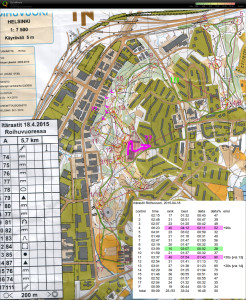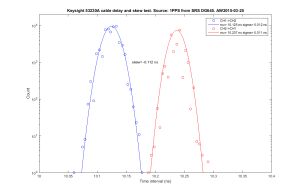Hmm, what happened here?
12V 1A SMPS for Cisco EPC3000 cable modem. Worked for many years but suddenly blew a fuse and died today. Replaced for 8 euros from Biltema.
Quite tentatively towards #1, catching the big cliff (yellow arrow) more by luck than skill and from there the control.
On #6 and #7 I tried to avoid the slow green areas but in hindsight my route is too zigzaggy. #9 ran out of steam a bit. #10 is the best split as I crossed the big path as planned and found the control via the big stone and swamp.
#11 is an identification mistake where I mistook a stone lower down for a one upper on the hillside (yellow arrow), resulting in a loop back to the control.
On github: https://github.com/aewallin/digiclock
A simple clock display with local time, UTC, date (iso8601 format of course!), MJD, day-of-year, and week number. Useful as a permanent info-display in the lab - just make sure your machines are synced with NTP.
1 2 3 4 5 6 7 8 9 10 11 12 13 14 15 16 17 18 19 20 21 22 23 24 25 26 27 28 29 30 31 32 33 34 35 36 37 38 39 40 41 42 43 44 45 46 47 48 49 50 51 52 53 | # use Tkinter to show a digital clock # tested with Python24 vegaseat 10sep2006 # https://www.daniweb.com/software-development/python/code/216785/tkinter-digital-clock-python # http://en.sharejs.com/python/19617 # AW2015-04-24 # added: UTC, localtime, date, MJD, DOY, week from Tkinter import * import time import jdutil # https://gist.github.com/jiffyclub/1294443 root = Tk() root.attributes("-fullscreen", True) # this should make Esc exit fullscrreen, but doesn't seem to work.. #root.bind('',root.attributes("-fullscreen", False)) root.configure(background='black') #root.geometry("1280x1024") # set explicitly window size time1 = '' clock_lt = Label(root, font=('arial', 230, 'bold'), fg='red',bg='black') clock_lt.pack() date_iso = Label(root, font=('arial', 75, 'bold'), fg='red',bg='black') date_iso.pack() date_etc = Label(root, font=('arial', 40, 'bold'), fg='red',bg='black') date_etc.pack() clock_utc = Label(root, font=('arial', 230, 'bold'),fg='red', bg='black') clock_utc.pack() def tick(): global time1 time2 = time.strftime('%H:%M:%S') # local time_utc = time.strftime('%H:%M:%S', time.gmtime()) # utc # MJD date_iso_txt = time.strftime('%Y-%m-%d') + " %.5f" % jdutil.mjd_now() # day, DOY, week date_etc_txt = "%s DOY: %s Week: %s" % (time.strftime('%A'), time.strftime('%j'), time.strftime('%W')) if time2 != time1: # if time string has changed, update it time1 = time2 clock_lt.config(text=time2) clock_utc.config(text=time_utc) date_iso.config(text=date_iso_txt) date_etc.config(text=date_etc_txt) # calls itself every 200 milliseconds # to update the time display as needed # could use >200 ms, but display gets jerky clock_lt.after(20, tick) tick() root.mainloop() |
This uses two small additions to jdutil:
1 2 3 4 5 6 7 | def mjd_now(): t = dt.datetime.utcnow() return dt_to_mjd(t) def dt_to_mjd(dt): jd = datetime_to_jd(dt) return jd_to_mjd(jd) |
 Easy course with lots of running along paths. From #3 I ran towards #15 for a bit before realizing the correct direction towards #4 - worst split. #9 is the best split - no orienteering required, just running. #11 is again slow and would have been faster along the road/path instead of over the hill via #13.
Easy course with lots of running along paths. From #3 I ran towards #15 for a bit before realizing the correct direction towards #4 - worst split. #9 is the best split - no orienteering required, just running. #11 is again slow and would have been faster along the road/path instead of over the hill via #13.
First 'real' orienteering event for this season - yay!
Good speed at the start with a 7th place overall at control #3. Then the wheel start to rattle at #4-#5-#6 and completely fall off for the last third of the course. No major mistakes - just the engine overheating after overcooking the start... 🙂
The roads are mostly washed and free of gravel/sand...until about ring-II (13km). There's a new XXL store at around 16km. Some indecision around Espoo center 22-24km with the bike-path not very clearly marked. A quick stop for a drink & snickers just before 40 km, then into Helsinki central park which is now free of snow. Punctured the rear wheel at about 52 km so I had to walk about 2 km home.
We got a new 53230A counter to the lab, so I decided to run some basic tests on it.
I collected time interval data using a 1-PPS source (H-maser through a SRS DG645), and wired this with a T-connector from CH1 to CH2 with a ~1 m (10 ns delay) cable. This should show the noise floor for time interval measurements as well as CH1/CH2 timing skew when measured the other way around (i.e. from CH2 to CH1). The 10 MHz external reference (at the back) was connected to a H-maser.

The results show standard deviations of 12 ps (CH1->CH2) and 11 ps (CH2->CH1) respecively, with a channel skew of 112 ps. Compare to the single-shot spec of sqrt(2)*20 ps = 28 ps and Agilent/Keysight's marketing video on youtube.
I also collected 10 MHz frequency counter readings on CH1 (source: H-maser) with gate times of 0.1 s, 1.0 s, and 10.0 s. I collected the data with a simple program that just calls the "READ?" function repeatedly, which does result in some dead-time between measurements.
Here are the results in terms of Allan deviation. I used allantools.
The time interval noise floor looks like white phase noise with an Allan deviation of 1.8e-11/tau. This is consistent with the 12 ps RMS value found above. It is left as an exercise for the reader to show that ADEV(1s) = sqrt(3)*RMS-time-interval-noise (correct??).
The frequency counting noise floor depends on the gate time, and I get 5e-12/sqrt(tau), 2e-12/sqrt(tau), and 6e-13/sqrt(tau) for gate times of 0.1 s, 1.0 s, and 10.0 s, respectively. This looks like white frequency noise. Enrico Rubiola has notes on frequency counters that may explain the numbers.